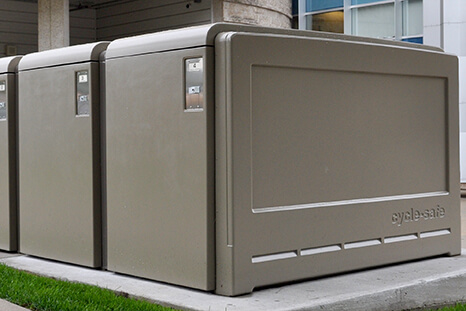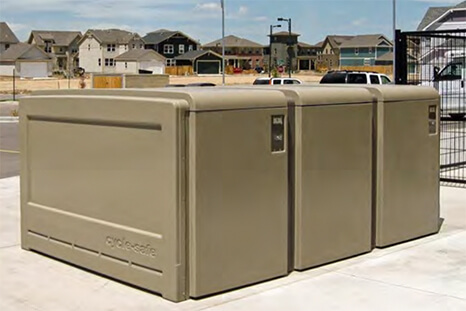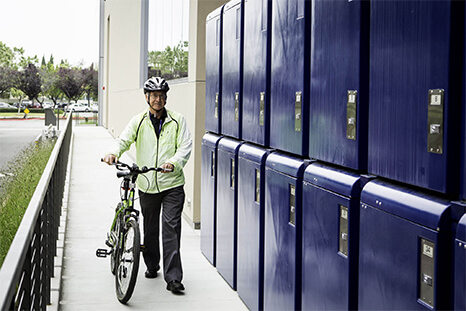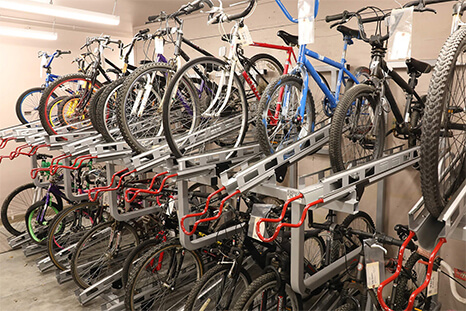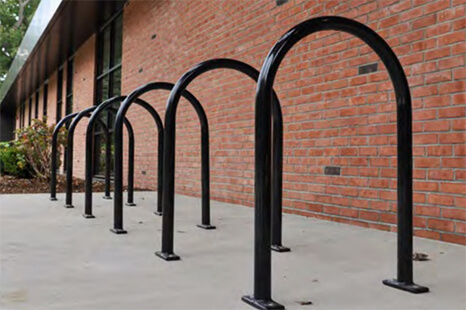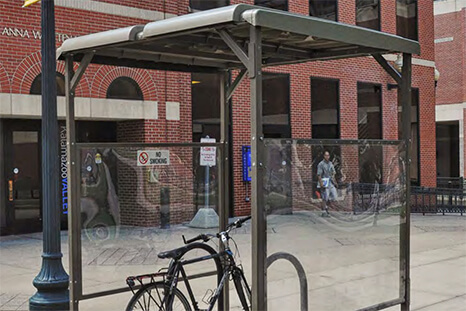Edmonton, Alberta, Bicycle Parking Regulations
In Edmonton, Alberta, bike parking regulations are outlined in the City of Edmonton Zoning Bylaw 12800. These regulations ensure both long-term (Class A) and short-term (Class B) bicycle parking facilities are incorporated into developments across residential, commercial, and institutional uses.
Long-Term Bicycle Parking Requirements
- Purpose: Class I bicycle parking is for long-term use, designed for residents, employees, or individuals who need secure and weather-protected storage.
- Location: These spaces must be located in secure areas such as enclosed bike rooms, lockers, or cages, typically inside buildings or parking structures.
- Quantity: For multi-unit housing, other residential developments and offices, 85-90% of the total required bicycle parking spaces must be allocated to Class I (long-term) parking. For commercial or non-residential developments, a minimum of 10% of all required bicycle parking must be Class long-term spaces if the total number of bike parking spaces exceeds 10.
Short-Term Bicycle Parking Requirements
- Purpose: Class II parking is meant for short-term use by visitors or customers.
- Location: These spaces must be placed near building entrances, typically within 15 meters, for easy public access and visibility.
- Quantity: 10% of all required bicycle parking spaces must be short-term spaces. This applies across both residential and commercial developments.
Design Standards for Long-Term Bicycle Parking
- Security: Long-term parking spaces must be secure, weather-protected, and accessible only by authorized users.
- Size and Clearance: Each space must have a minimum width of 0.6 meters, a length of 1.8 meters, and a vertical clearance of 2 meters. These spaces should accommodate standard bicycle sizes with sufficient clearance for easy maneuvering.
Design Standards for Short-Term Bicycle Parking:
- Visibility and Accessibility: Short-term spaces must be in highly visible areas, close to entrances, and must be well-lit to enhance security.
- Rack Design: Racks should allow cyclists to lock the frame and one wheel of the bicycle securely. The racks must also support the bicycle in an upright position to prevent damage or falling over.
Minimum Number of Bike Parking Spaces for Edmonton, AB
| Use | Minimum Number of Bike Parking Spaces |
|---|---|
| Commercial Uses, Community Uses, Health Care Facilities, and Transit Centres, where less than 2,500 m of Floor Area | 2.0 spaces for the first 280 m of Floor Area and 1.0 space per additional 140 m of Floor Area |
| Commercial Uses, Community Uses, Health Care Facilities, and Transit Centres where greater than or equal to 2,500 m of Floor Area | 18.0 spaces for the first 2,500 m of Floor Area and 1.0 space per additional 414 m of Floor Area |
| Multi-unit Housing, Supportive Housing, or Lodging House, with 9 or more Dwellings or Sleeping Units | 1.0 spaces per Dwelling or per 3 Sleeping Units, whichever is greater |
The above information represents a partial list of the facility types and their bike parking requirements for Edmonton, AB. Please refer to the link below for more detailed information.
Number of Inclusive Bike Parking Spaces Required
A minimum of 10% of required short term Bike Parking spaces, or one short term bike parking space, whichever is greater, must be Inclusive bike parking. Inclusive bike parking means a horizontal bike parking space that accommodates non-standard bikes, or spaces for bikes that are difficult to lift. Typical examples of non-standard bikes include cargo bikes, fat tire bikes, e-bikes, handcycles, or bikes with trailers.
A minimum of 10% of required long-term bike parking spaces, or one long-term bike parking
space, whichever is greater, must be Inclusive bike parking. Inclusive bike parking means a horizontal bike parking space that accommodates non-standard bikes, or spaces for bikes that are difficult to lift. Typical examples of non-standard bikes include cargo bikes, fat tire bikes, e-bikes, handcycles, or bikes with trailers.
Regional or Neighborhood-Specific Requirements
In special zones like downtown Edmonton or near transit-oriented developments, additional requirements may apply to increase the availability of bike parking. For example: For non-residential uses with a gross floor area greater than 5,000 square meters, change rooms, showers, and covered secured parking areas must be provided to the satisfaction of the development planner. LEED™ standards must be used to calculate the required areas.
Other areas, such as West Jasper Place, north of 95 Avenue and west of 153 Street NW, have specific bike parking requirements. Please refer to the link below for additional details.
Official Regulations
The official regulations can be accessed through the City of Edmonton Zoning Bylaw 12800, Part 5.80, which details the full requirements for bicycle parking.

